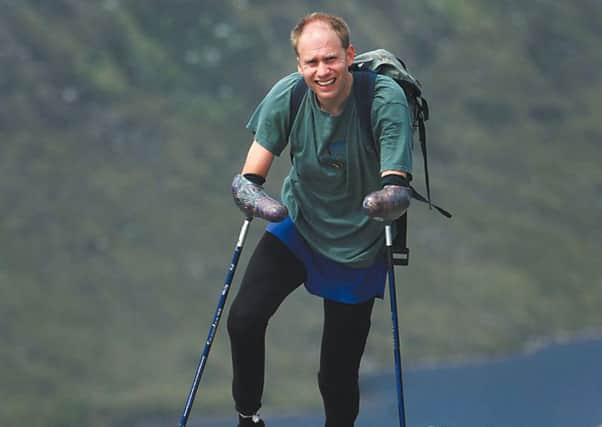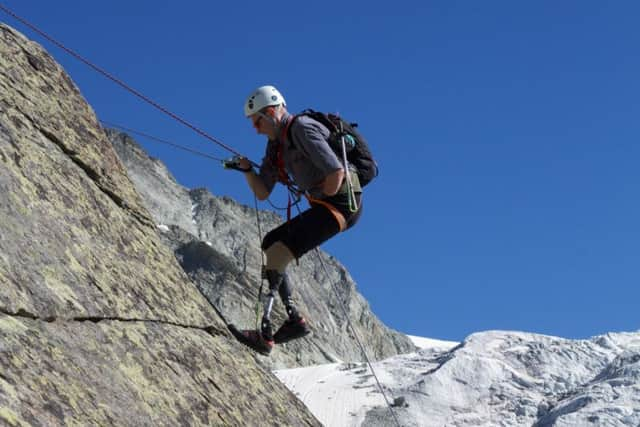Jamie aims to inspire others to reach for the summit


The Scots mountaineer lost both of his feet and hands to frostbite in 1999 after becoming stranded on the summit of Les Droites in the French Alps.
But at least he survived. His climbing partner and friend Jamie Fisher died from hypothermia before the duo could be rescued.
Advertisement
Hide AdAdvertisement
Hide AdThe remarkable story of how Andrew not only rebuilt his life but soon returned to climbing has inspired countless people around the world.


Today, the 47-year-old from Edinburgh is a full-time motivational speaker and helps to promote good causes across the country.
It’s been a long journey from his initial recovery in a French hospital.
“I wasn’t thinking in terms of I would never climb again - I thought I would never do anything again,” he said.
“I was in hospital without hands or feet. Bear in mind, 17 years ago, there was no blanket Paralympic coverage and much less information available about what disabled people could achieve.”


Slowly, Andrew realised he had to rebuild his life - not only for himself, but as a lasting tribute to his climbing buddy who didn’t get the chance.
“Part of my recovery it was realising I had reached a low point - this was the bottom,” he said. “I was the lucky one.
“I cant understate the amount of support I received from others which helped me to adjust my mind set to see this as an opportunity rather than outright tragedy.
Advertisement
Hide AdAdvertisement
Hide Ad“In the beginning I didn’t have any notion of getting back on to the hills. It was more about learning to feed myself; dress myself; and all of that. But I made such rapid progress with all of that I started daring to dream.”
Remarkably, Andrew was able to undertake a solo ascent of Ben Nevis just a year after the tragedy - raising thousands for charity in the process.
That incredible story never ceases to amaze those who hear Andrew speak.
This week, he’ll be sharing his experiences at the launch of The Push, which bills itself as “toughest sporting challenge in Scotland”.
The event, which takes place on September 10, sees entrants walk up to 26.2 miles and climb over 2,000 meters in height.
Cash raised on the day will go to St Columba’s Hospice in Edinburgh, which provides free specialist care for people at the end of their lives, as well as providing care and support for the patient’s loved ones.
Although he will be unable to participate on the day due to prior commitments, The Push is the kind of event that Andrew fully supports.
“It’s always good to motivate yourself by taking on a challenge, making a commitment and hopefully raising a bit of money along the way,” he said.
Advertisement
Hide AdAdvertisement
Hide Ad“My accident was 17 years ago and I’ve been involved in fundraising ever since.”
Andrew’s love of the outdoors dates back to his childhood in Bearsden. He began climbing at 16 and would later become president of the University of Edinburgh’s mountaineering club.
By 1999 he was an experienced climber.
Disaster struck when he and Fisher reached the summit of Les Droites in the Mont Blanc massif and were beset by snow, 90 mph winds and temperatures of -30°C.
They endured four days on the mountain. Fisher, tragically, died shortly before help could arrive.
After undergoing a double amputation, Andrew became determined to return to the hills.
“I had to come up with a lot of the equipment myself,” he said. “I had help from my prosthetists, who were delighted to be involved with a patient who wanted to do something new.”
Andrew is now a contented father of three, and fulfils around 50 speaking engagements a year.
His rates his most satisfying accomplishment as not returning to climbing, but helping others to overcome tragic events.
Advertisement
Hide AdAdvertisement
Hide Ad“I helped push back the boundaries of what amputees could do,” he said. “It’s about the attitude - to show that these things are possible.
“My story is something people can relate to - even if they are not mountaineers or amputees. How would they react if something like that happened in my life? A story like mine can give people heart to turn around even the most difficult of challenges.”
